24 September 2004
Copyright © Uri Davis
Copyright © Uri Davis
Foreword
This my address above I delivered, inter alia, on the date above in Ottawa, at the Azrieli Building, Room 101, Carleton University - the 24th Day of September in the Year 2004 being the holiest day in the Jewish confessional calendar, Yom Kippur, the Day of Atonement, the night when the prayer of Kol Nidrei is recited. And I chose to do so advisedly.I believe that when the sponsors of my lecture tour in North America, 13-29 September 2004, coordinated the various schedules of my itinerary they were not aware that the above falls on Yom Kippur. When, having perused my itinerary I realized that this was the case - I chose to leave the date of the said engagement unaltered. I made this choice because the alternatives that were on offer were not particularly attractive.
I am a something of an old fashioned liberal, and subscribe strongly to the principle of separation of religious identity from the state. I owe to my colleague and teacher Akiva Orr the extension of this liberal principle to include separation of national identity from the state as well as separation of tribal identity from the state (Orr, 1994). I am able to confidently and unapologetically celebrate such elements in my religious, national and tribal heritage as are compatible with the values of the Universal Declaration of Human Rights, precisely because I do not wed my religious affiliations, national affiliations or tribal affiliations to the state.
And such elements in my religious, national and tribal heritage as are not compatible with the values of the Universal Declaration of Human Rights I reject and denounce. I am not a theological Jew, and I do not subscribe to the claim that the Old Testament (or, for that matter, the New Testament or the Quran) are divine narratives, the words of God. Neither do I wish to be affiliated to the political Zionist construction of the "Jewish people". I identify myself and project my identity as Jewish in terms of membership of the Jewish tribe, or more precisely, in tems of membership of one of the European Jewish tribes. And, as noted above, I rejoice in celebrating such sections of my tribal heritage as are compatible with the values of the Universal Declaration of Human Rights and reject and denounce such as are not. I mark my male offsprings with the mark of my tribe: circumcision.
Thus, I place myself squarely in the camp that classifies religious, national or tribal pursuits as pursuits that belong and ought to remain firmly in the private sphere, as well as insists that just as it is none of the business of the state to intervene in matters pertaining to the sexual preferences to two consenting adults between the sheets, subject to the values of the Universal Declaration of Human Rights, it is none of the business of the state to intervene in the exercise of religious, national or tribal preferences of its citizens, again, subject to the values of the Universal Declaration of Human Rights.
To my mind, the wedding religion (or nationalism or tribalism) to the state is repugnant. As the late Yeshaayahu Leibowitz, tirelessly pointed out "[t]here is no greater degradation of religion than maintenance of its institutions by a secular state" (Leibowitz 1992: 176), and "what obtains officially today as the religion of Israel and what appears in the world as the official Jewish religion - is a concubine which is maintained by the secular regime [of the State of Israel]." Never known to mince his words, Leibowitz contnues: "and what is referred to as the 'religious establishment' - and I do not hesitate to say so in public - is the pimp of this concubine!" (Leibowitz, 1987:35). To the best of my knowledge there was not a single Jewish synagogue, the locus of congregation of my tribe in Ottawa on the said day, that did not include in its Day of Atonement service the impropriety of a including in the most individually intimate prayer of Yizkor (Memorial of Departed Souls, recited in remembrance of one's departed father, mother, grandparents, uncles/aunts, brothers/sisters, children, spouses, extended family and martyrs) also a prayer for members of the Israel Defence Force:
May God remember the souls of the soldiers of the Israel Defence Force who gave their lives for the sanctification of God's name, the nation and the land; who fell heroic death in missions of liberation, defence and security. Sanctification of God's name through ethnic cleansing?
Given this appalling circumstance, I felt that delivering a critical lecture in Ottawa on the subject of the Jewish National Fund, specifically, the Jewish National Fund of Canada, in defence of the rights of the Palestinian Arab inhabitants of 'Imwas, Yalu and Beit Nuba, ethnically cleansed by the Israeli army in the course of the 1967 war, criminally leveling their homes and razing their villages to the ground, over the ruins of which, inter alia, JNF Canada funded the planting of the trees and the developing of the recreational facilities that were inaugusrated as "Canada Park", was the ethically a viable and correct choice, perhaps the only viable choice available to me as a person attempting to remain a decent Jew in the context of my lecture tour in Canada, especially on that date, the Jewish Day of Atonement, 2004. Introduction and Acknowledgments It so happens that the Palestinian Arab village of 'Imwas is regarded in professional archeological and church literature as one of the likely location of the New Testament Emmaus, on the road towards which Jesus Christ is reported to have walked after his alleged resurrection.
Luke tells the story of that first Easter afternoon when the risen Christ appeared to the two disciples who were walking together along the road from Jerusalem to Emmaus. The risen Christ "came near and went with them," opening the disciples' eyes to his presence and lighting the fire of God's love in their hearts. As they walked to Emmaus, Jesus explained to them the meaning of all the scriptures concerning himself. When they arrived in Emmaus, Jesus "took bread, blessed and broke it, and gave it to them," and their eyes were opened. They recognized him as Jesus, the risen Lord, and they remembered how their hearts had burned within them as they talked with him on the road. Within the hour, the two disciples left Emmaus and returned immediately to their friends in Jerusalem. As they told stories about their encounters with the risen Lord, Jesus visited them again with a fresh awareness of his living presence. (Based on http://www.upperroom.com/emmaus/whatis/name.asp )
There is no scholarly consensus regarding the location in Palestine of the New Testament Emmaus. In addition to the location as accepted in this Paper, other sites have been recommended as ancient Emmaus. First, al-Qubayba (Palestinian Arab village destroyed and ethnically cleansed by the Israeli army in the course of and in the wake of the 1948-49 war, and on whose lands, inter alia, the cooperative Moshav Ge'alyah (for Jews only) was established). This was a site favored by the Crusaders, who found an old Roman fort near el-Qubeibeh named Castellum Emmaus. A Byzantine church was excavated here by the Franciscans beginning in 1873; second, Abu Ghosh, (most of whose lands were confiscated to establish, inter alia, the cooperative Kibbutz Qiryat Anavim (for Jews only)), identified as Old Testament Qiryat Ye'arim, also known as Qaryat al-'Anab (City of Grape[s]). There is a Roman fort at Abu Ghosh with a Greek inscription that mentions the Tenth Legion stationed there; third, Qaluniya, or ancient Colonia, often identified with the Motza of the Jerusalem Talmud (Palestinian Arab village of Qaluniya too was destroyed and ethnically cleansed by the Israeli army in the course of and in the wake of the 1948-49 war, and on whose lands, inter alia, Mevaseret Zion, the leafy suburb of Jerusalem (for Jews only) was established). The photograph below depicts the mixed Catholic Communaute des Beatitudes at Emmaus/Nicopolis and a section of the archeological excavations of the ancient Roman, Byzantine and Crusader remains. Today, these sacred ruins are the only evidence of the existence of the city in this site. (Based on http://www.christusrex.org/www1/ofm/mad/discussion/069discuss.html and Walid Khalidi, 1992: 220-21, 309-10)
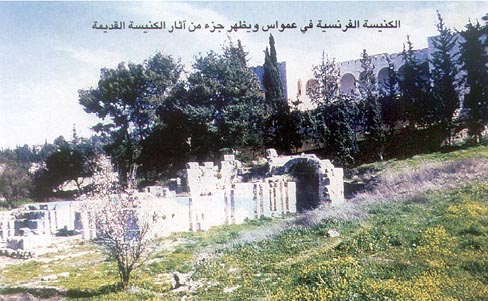
|
In the course of the 1967 war the Israeli army occupied 'Imwas and the neighbouring villages of Yalu and Beit Nuba and forcibly expelled, ethnically cleansed, their civilian unarmed inhabitants, men women and children, the life of most of whom has since then been reduced to the misery of refugee statelessness. Over the ruins of the three villages of 'Imwas, Yalu and Beit Nuba and their lands the Jewish National Fund of Canada funded the planting of trees and the development of recreational facilities inaugurated during the term of office of the late Bernard Bloomfield as President of the Jewish National Fund of Canada, 1971-1975 as "Canada Park". It is not that I was not aware of the history of Canada Park, situated as it is inside the post-1967 occupied territories of the West Bank, in the Latrun Salient, a sliver of land, in the shape of a thumb, hugging the road to Jerusalem, prior to the publication of Walter Lehn's article in "A West Bank Sojourn" in 1980. I was a student at the Hebrew University in Jerusalem at the time of the 1967 war, and have since led numerous individuals and groups on critical visits to Canada Park as an illustration of the illegal settler-colonial complicity of the JNF in war crimes and crimes against humanity in general, and in the post 1967 occupied territories in particular. In due course I had published, as associated author together with Walter Lehn, author, the only comprehensive independent critical history of the JNF available in the English Language, The Jewish National Fund in 1988. But it was, alas, only much later, after visiting the JNF pavilion in the UN World Summit on Sustainable Development (WSSD), in 2002, which I had attended as a member of the delegation of ITTIJAH: Union of Arab Community Based Associations, that I became concretely, tangibly and fully aware of the critical role of the JNF overseas in the regrettably hitherto successful endeavour by the World Zionist Organization (WZO) and the Embassies of the State of Israel worldwide in projecting the State of Israel, an apartheid state, as "the only democracy in the Middle East".
Registered as an NGO (which it is not), the JNF at the said UN World Conference on Sustainable Development, projected itself as a non-governmental organization committed to sustainable development (e.g., river section rehabilitation, soil conservation, fire fighting vehicles, fire watchtowers, savanization projects and such like), and on the ground of such misrepresentation claiming and getting registered as a charity benefitting from tax exemptions in all or most member states of the United Nations Organization.
I owe the people of 'Imwas, Yalu and Beit Nuba an apology for the delay in the publication of this study, and for the delay in initiating the related action of litigation against the JNF and its officers in Canada on the basis of the evidence of JNF complicity in crimes against humanity. This study and its related litigation ought to have been motivated some three and a half decades ago. That this was not to be may be explained, and possibly justified, by circumstance. But alleviating circumstances notwithstanding, it still remains the case that every delay in this regard entails yet an additional extension of the crippling suffering of the people of 'Imwas, Yalu and Beit Nuba.
And I owe the peoples of South Africa, led by the African National Congress (ANC) and inspired by the admirable leadership of Nelson Mandela, my profoundest gratitude for their contribution to humanity as a whole, through their achievements and successful struggle over many decades, resulting in the dismantlement of the apartheid legislation in the Republic of South Africa and its replacement with a democratic constitution. There is little doubt in my mind that the success of the struggle in South Africa for a constitutional democracy informed by the values of the Universal Declaration of Human Rights has played a critically significant role in the creation of an international environment that is progressively more attentive to the rights and wrongs of the Israeli-Palestinian conflict and the justice of the struggle against Israeli apartheid in solidarity with the struggle of the indigenous Palestinian Arab people for their fundamental rights, as enshrined in international law and all UN resolutions on the question of Palestine, notably, their right to return and to the titles to their properties inside the State of Israel.
This study, and the related legal action to be motivated in its wake in the course of my lecture tour in North America 13-29 September 2004, would not have been made possible without the generous and extensive support of the many civil society networks in Palestine and North America, in the first instance the relentless struggle of the refugees of 'Imwas, Yalu and Beit Nuba in defence of their right to return and to the titles to their properties; the Emmaus Charitable Association, notably Nihad and Adnan Abu Ghosh; AL-BEIT: Association for the Defence of Human Rights in Israel, notably Advocate Tawfiq Jabarin; PASSIA: Palestinian Academic Society for the Study of International Affairs, notably Mahmoud Abu Rumeileh; ADDAMEER: Prisoners Support and Human Rights Association, notably Khalida Jarrar; SOLIDARITY, notably David Finkel and Peter Solenberger; Interfaith Council for Peace and Justice of Ann Arbor, notably Harry Clark; Students Allied for Freedom and Equality, notably Carmel Salhi; Palestine Office, notably Hasan Newash; ADC: American-Arab Anti-Discrimination Committee, notably Nabeel Ibraham; St Andrew's Episcopal Church of Clawson, notably Harry Cook; WPC: Windsor Peace Coalition, notably Margret Villamizar; OPIRG: Ontario Public Interest Research Group, notably Jim Davies; London Canadian Palestinian Association, notably Robert
Rabah; SPHR: Solidarity for Palestinian Human Rights, University of West Ontario notably Rasha Tawil; Palestine House, notably Elias Hazineh; NECEF: Near East Cultural and Educational Foundation of Canada, notably Jim Graff; JWAO: Jewish Women Against the Occupation, notably Judith Weisman; SPHR: Solidarity for Palestinian Human Rights, York University, notably Dennis Badeen; Kingston for Palestinian Human Rights, notably Akrum Matuk; NCCAR: National Council on Canada-Arab Relations, notably Mazen Chouaib; CPA: Canada Palestine Association, notably Ismail Zayid; PAJU: Palestinian Arab and Jewish Unity, notably Janette Weinroth; ALTERNATIVES: Communication and Action for International Development Network, notably France-Isabelle Langlois; SPHR: Solidarity for Palestinian Human Rights, McGill University, notably Chadi Maaruf; JAAO: Jewish Alliance Against the Occupation, notably Eibie Weizfeld; and research assistance by Shelly Nativ.
But most emphatically I owe profound thanks to Advocate Edward Corrigan and Annik Lussier for devoting their time over the eight months preceding my said tour to coordinating my tour in North America under the title above; David Finkel and Amy Good, Rabia and Farouq Shafie, Hasan Newash, Karin and Michael Brothers, Nahla Abdo and Sami Zu'bi; Faraj and Carol Nakhleh; and Ahmad Eed Murad for their hospitality; Michael Friedman for assistance with the preparation of my PowerPoint presentation; and Walter Lehn and his wife Ghada Jayyusi Lehn for their critical support in assisting me assemble relevant documentation in the course of my travel along the route of my tour.
Unless otherwise stated, all photographs were taken by this writer.
Eyewitness Report by Reserve IDF Soldier Amos Kenan
Written in June 1967, and incorporated in Amos Kenan, Israel: A Wasted Victory, 1970, the eyewitness report of the razing of the three Palestinian Arab villages of 'Imwas, Yalu and Beit Nuba, are narrated by Amos Kenan as follows (photographs added by Uri Davis, courtesy of the 'Imwas Charitable Association): The commander of my platoon said that it had been decided to blow up the three villages in the sector- Yalu, Beit Nuba, and 'Imwas. For reasons of strategy, tactics and security. In the first place to straighten out the Latrun 'finger'. Secondly, in order to punish these murderers' dens. And thirdly, to deprive infiltrators of a base in future.One may argue with this idiotic approach which advocates collective punishment and is based on the belief that if the infiltrator loses one house, he will not find another from which to wait in ambush. One may argue with the effectiveness of increasing the number of our future enemies - but why argue? We were told it was our job to search the village houses: that if we found any armed men there, they were to be taken prisoner. Any unarmed persons should be given time to pack their belongings and then told to get moving - get moving to Beit Sira, a village not far away. We were told also to take up positions around the approaches to the villages in order to prevent those villagers who had heard the Israeli assurances over the radio that they could return to their homes in peace - from returning to their homes. The order was - shoot over their heads and tell them there is no access to the village.
The homes in Beit Nuba are beautiful stone houses, some of them luxurious mansions. Each house stands in an orchard of olives, apricots and grapevines, there are also cypresses and other trees grown for their beauty and the shade they give. Each tree stands in its carefully watered bed. Between the trees lie neatly hoed and weeded rows of vegetables.
In the houses we found a wounded Egyptian commando officer and some old men and women. At noon the first bulldozer arrived, and ploughed under the house closest to the village edge.
With one sweep of the bulldozer, the cypresses and the olive trees were uprooted. Ten or more minutes pass and the house, with its meagre furnishings and belongings, had become a mass of rubble. After three houses had been mowed down, the first convoy of refugees arrives, from the direction of Ramallah. (http://www.al-bushra.org/palestine/emmaus1.html)
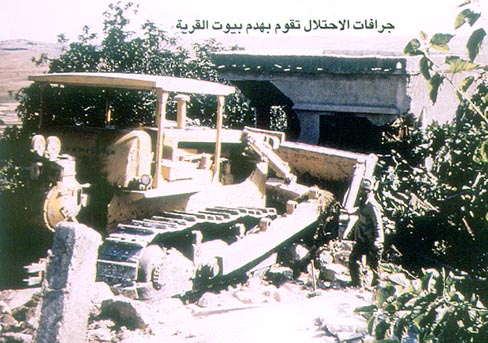
|
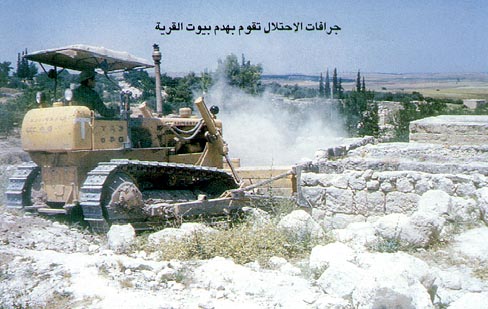
|
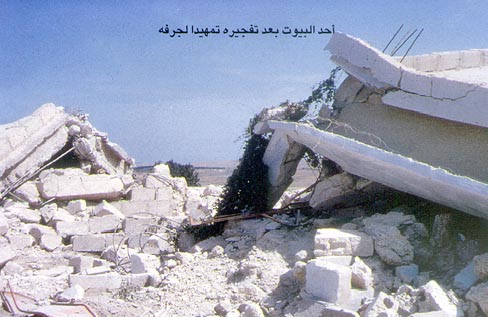
|
We did not shoot into the air. We did take up positions for coverage, and those of us who spoke Arabic went up to them to give them the orders. There were old men hardly able to walk, old women mumbling to themselves, babies in their mother's arms, small children, small children weeping, begging for water. The convoy waved white flags.
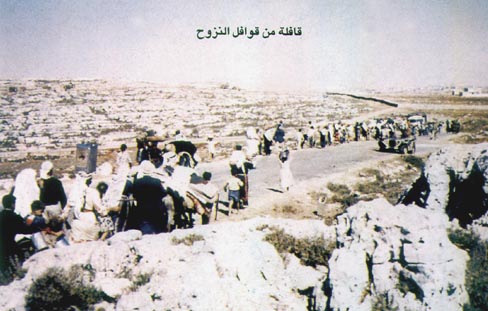
|
We told them to move on to Beit Sira. They said that wherever they went, they were driven away, that nowhere they were allowed to stay. They said they had been on the way for four days now- without food or water; some had perished on the way. They asked only to be allowed back into their own village, and said that we would do better to kill them. Some had brought with them a goat, a sheep, a camel or a donkey. A father crunched grains of wheat in his hand to soften them so that his four children might have something to eat. On the horizon, we spotted the next line approaching. One man was carrying a 50- kilogram sack of flour on his back, and that was how he had walked mile after mile. More old men, more women, more babies. They flopped down exhausted at the spot where they were told to sit. Some had brought along a cow or two, or a calf- all their earthly possessions. We did not allow them to go into the village to pick up their belongings, for the order was that they must not be allowed to see their homes being destroyed. The children wept, and some of the soldiers wept too. We went to look for water but found none. We stopped an army vehicle in which sat a Lieutenant-Colonel, two Captains and a woman. We took a gerry-can of water from them and tried to make it go round among the refugees. We handed out sweets and cigarettes. More of our soldiers wept. We asked the officers why the refugees were being sent back and forth and driven away from everywhere they went. The officers said it would do them good to walk and asked "why worry about them, they're only Arabs?" We were glad to learn that half-an-hour later they were all arrested by the military police, who found their car stacked with loot.
More and more lines of refugees kept arriving. By this time there must have been hundreds of them. They couldn't understand why they had been told to return and now were not being allowed to return. One could not remain unmoved by their entreaties. Someone asked what was the point of destroying the houses - why didn't the Israelis go live in them instead? The platoon commander decided to go to headquarters to find out whether there was any written order as to what should be done with them, where to send them and to try and arrange transportation for the women and children, and food supplies. He came back an said there was no written order, we were to drive them away. Like lost sheep they went on wandering along the roads. The exhausted were beyond rescuing. Toward evening we learned that we had been told a falsehood - Beit Sira too the bulldozers had begun their work of destruction, and the refugees had not been allowed to enter. We also learned that it was not in our sector alone that areas were being 'straightened out'; the same thing was going on in all sectors. Our word had not been a word of honor, the policy was a policy without backing.
The soldiers grumbled. The villagers clenched their teeth as they watched the bulldozers mow down trees. At night we stayed on to guard the bulldozers, but the entire battalion were seething with anger; most of them did not want to do the job. In the morning we were transferred to another spot. No one could understand how Jews could do such a thing. Even those who justified the action said that it should have been possible to provide shelter for the population, that a final decision should have been taken as to their fate, as to where they were to go.
The refugees should have been taken to their new home, together with their property. No one could understand why the fellah should be barred from taking his oil-stove, his blanket and some provisions. The chickens and the pigeons were buried under the rubble. The fields were turned to desolation before our eyes, and the children who dragged themselves along the road that day, weeping bitterly, will be the fedayeen of 19 years hence. This is how that day, we lost the victory. (Amos Kenan, Israel: A Wasted Victory, 1970, pp 18-21)
An odd quarter of a century later, in 1991, the Canadian Broadcasting Corporation (CBC) Fifth Estate Programme, broadcasted Trish Wood's documentary film on Canada Park, entitled "Park With No Pecae". For her documentary film Trish Wood interviewed a number of Jewish citizens of Israel, including Amos Kenan, who stood by his testimony above; former MK Uri Avnery, who properly referred to the destruction of 'Imwas, Yalu and Beit Nuba as a war crime under international law, the development of Canada Park over the ruins of the said three destroyed Palestinian Arab villages as complicity with war crimes, and the endorsement of the naming of the park after the name of the Canada as implicating Canada with giving a cover to war crimes; and the late Prime Minister Yitzhaq Rabin who confirmed that it was he, as Chief-of-Staff of the Israel Defence Forces, who gave the order to level the villages and raze them to the ground (Wood, 1991). When challenged by Trish Wood to the effect that this action was classified as war crimes under the Geneva Conventions of 1949, this is what Rabin had to say: Allow me to remind you that at war there are certain rules of war [pause] and whenever we are at war we will do whatever is needed to protect Israel, to defend Israel, to defend Israel's population (Wood, 1991)
Except that the rules of war, as regulated under the said Geneva Conventions of 1949, specifically and emphatically prohibit forcible expulsion of civilian populations from the localities of residence, ethnic cleansing or razing the homes of civilian populations to the ground. Such actions are classified as war crimes and crimes against humanity under international law.
And when further challenged by Trish Wood to the effect that: If there is ever to be Peace here many believe Israel will have to trade land for it. The hatred each side holds for the other is as deeply rooted in Canada Park as anywhere in the Middle East. For the Palestinians the land the Park sits on represents their birth right. For the Israelis the security of their nation. Rabin replies: I don't see any Israeli leader that will give it up� Because we need it for Israel's security. To maintain the line of the road between Tel Aviv and Jerusalem sec� Totally secure. As you wouldn't� wouldn't allow that the road between Toronto and Ottawa will be controlled by a potential enemy of Canada.
Needless to say that the comparison of the Tel Aviv-Jerusalem highway to the Toronto Ottawa highway is utterly misplaced, since Israel's claims to Jerusalem as the Capital of the State of Israel are wholly illegal. Israeli actions and legislation with reference to Jerusalem represent a blatant violation of a host of UN General Assembly and Security Council resolutions, beginning with UN General Assembly Resolution 181(II) of November 1947 (recommending the establishment of independent Arab and Jewish states and a corpus separatum for the City of Jerusalem under Special International Regime to be administered by the UN) through UN Security Council Resolution 242 of November 1967 (emphasizing the inadmissibility of acquisition of territory by war), and UN Security Council Resolution 478 of August 1980 (affirming that the enactment of the "Basic Law: Jerusalem, the Capital of Israel" by Israel in 1980 constitutes a violation of international law and a serious obstruction to achieving a comprehensive, just and lasting peace in the Middle East) as well as UN General Assembly Resolution 58/22 of October 2003 (reiterating its determination that any action taken by Israel to impose its laws, jurisdiction and administration on the Holy City of Jerusalem are illegal and therefore null and void and have no validity whatsoever, and deploring the transfer by some States of their diplomatic missions to Jerusalem in violation of Security Council resolution 478 of 1980). It is, thus, less than surprising that given the denial mindset characterizing much political Zionist narrative, the late Prime Minister of the state of Israel, committed to the denial of the illegality of declaring Jerusalem as the Capital of the State of Israel, would seek to justify the defence of this illegality by another denial, namely the denial of the war crimes he ordered in 'Imwas Yalu and Beit Nuba, through the misguided analogy to the highway between Toronto and Ottawa. There are no UN General Assembly and Security Council resolutions stipulating that the declaration of Ottawa as the capital city of Canada constitutes a violation of international law.
Rabin's claims to the defence of the highway to Jerusalem as its presumed capital city are as illegal as his claims that it was justified for him to order the perpetration of war crimes and crimes against humanity in the case of 'Imwas, Yalu and Beit Nuba in the name of the defence and the security of the said highway.
It is not the first time that Rabin had perpetrated war crimes and crime against humanity in this area. As Commander of the Har'el Brigade, it was Yitzhaq Rabin, inter alia, who orchestrated, under the command of Yigal Allon the ethnic cleansing of the Palestinian Arab cities of Lydda and Ramle in what is referred to in Zionist annals as the Dani Operation. Shahak, The Zionist plans for the Middle East, (Appendix)1982:19-26.
As reported by David Shipler in 1979, while the fighting was still in progress, the senior command of the Israeli forces had to grapple with a troublesome problem, for whose solution they could not draw on any previous experience: the fate of the civilian population of Lydda and Ramle, numbering some 50,000. In a meeting that included Rabin, Ben Gurion and Yigal Allon the question of the cities of Lydda and Ramle was debated.
Not even Ben-Gurion could offer any solution, and during the discussions at operational headquarters, he remained silent, as was his habit in such situations. Clearly, we could not leave Lod's hostile and armed population in our rear, where it could endanger the supply route to Yiftach [another brigade], which was advancing eastward. We walked outside, Ben-Gurion accompanying us. Allon repeated his question: "What is to be done with the population?" B.G. waved his hand in a gesture which said "Drive them out!."
Allon and Rabin held a consultation. Rabin agreed that it was essential to drive the inhabitants out. They were taken on foot towards the Bet Horon Road, assuming that the legion would be obliged to look after them, thereby shouldering logistic difficulties which would burden its fighting capacity, making things easier for the Israeli army.
The population of Lydda did not leave willingly. There was no way of avoiding the use of force and warning shots in order to make the inhabitants march the 10 to 15 miles to the point where they met up with the Jordanian Arab Legion. The inhabitants of Ramle watched and seemed to have learned the lesson. Their Leaders agreed to evacuate voluntarily, on condition that the evacuation was carried out by vehicles. Buses took them to Latrun, and from there, they were evacuated by the legion.
Some of Rabin's soldiers refused to take part in the expulsion action. Prolonged propaganda activities were required after the action, to remove the bitterness of these youth-movement groups, and explain why the senior command was obliged to undertake such a harsh and cruel action.
The prolonged propaganda seemed to have worked. It took thirty odd years before the Rabin's first person account of the expulsion of the Palestinian Arab civilian population of the cities of Lydda and Ramle in the course of the 1948 war censored out of the first Hebrew and English editions of his memoirs saw the light of day. (Based on David K. Shipler , "Israel Bars Rabin From Relating '48 Eviction of Arabs", New York Times, 23 and 25 October 1979; Peretz Kidron, "Truth Whereby Nations Live" in Edward Said and Christopher Hitchens (eds), Blaming the Victim, 1988; & http://student.cs.ucc.ie/cs1064/jabowen/IPSC/articles/article0005217.txt) In 1994 Rabin in his capacity as Prime Minister of the State of Israel, together with Shimon Peres in his capacity of Foreign Minister of the state of Israel and Yasser Arafat in his capacity as Chairman of the Palestine liberation Organization were granted the Nobel Peace Prize in Oslo "for their efforts to create peace in the Middle East."
It is the view of this author that the said Nobel Prize for Peace ought to be withdrawn from Rabin posthumously and from Peres immediately.
'Imwas Prior to 1967
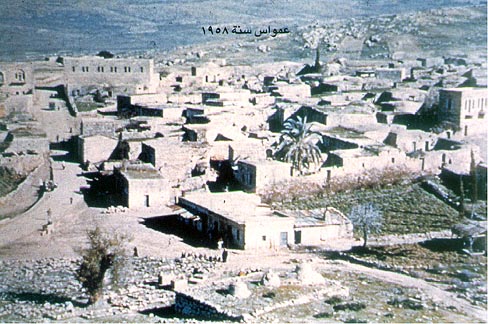
|
Israeli occupation date: 7 June, 1967.
Distance from district center: 12 (km) Southeast of Ramle.
Elevation from the sea: 200 meters.
Village defenders: Jordanian army and at the outbreak of the war some Egyptian commandoes.
Based on the orders of Yitzhaq Rabin, Israeli army Chief-of-Staff at the time, subsequently Prime Minister of the State of Israel and Nobel Prize laureate, armored jeeps broadcasted orders for the immediate eviction of the three villages of 'Imwas, Yalu, and Beit Nuba to the East Bank. The inhabitants were given only a few hours to gather their possessions, forcibly directing them towards Ramallah. To expedite the ethnic cleansing process, as in 1948 war, the Israeli army shot over the heads of the fleeing villagers to make sure they would not come back. Soon after, the three villages were bulldozed and dynamited by the Israeli army.
Neighboring towns: al-Latrun, Yalu, Deir Ayyub, Salbit, and al-Qubab. Village clans or hamulas: The village was mostly populated by the Abu Gosh family. Land ownership before occupation (Dunums): Arab, 5,151; Jewish, 0; Public, 16; Total: 5,167.
Population before occupation: 1922, 824; 1931, 1,021; 1945, 1,450 (including 2 Christians); 1961, 1,955 (40 Christians)
Number of houses: In 1931: 224.
Town's name through history: 'Imwas means "hot springs". In the year 70 Emmaus was renamed Nicopolis, that is "City of Victory" by the Roman conquerors of the country.
Schools: The village had two schools, the first of which was for boys which was founded in 1919, and in 1947 it became a full elementary school with 6 teachers and an enrollment of 187 pupils. Soon after al-Nakba, the boys' school became a full elementary and a secondary school with an enrollment of 304 boys in 1967. The boys' school also had a small library which contained 376 books. The second school was for girls which had an enrollment of 172 girls in 1967.
Inhabitants place of origin: The majority of the villagers belonged to the Abu Gosh family many of whom were ethnically cleansed from Abu Gosh or Qaryat al-'Anab, West of Jerusalem in 1948. A few of the inhabitants trace their roots back to Egypt. Religious institutions: Two Mosques
Shrines/maqams: Two shrines: The first belongs to Abu 'Ubydah Ibn al-Jarrah, the conqueror of Palestine (13 A.H./634 A.D.) from Byzantia at battle of Ajnadin. Although the shrine is still intact, it is deteriorating and in need of serious renovation. The second shrine/tomb for Mu'ath Ibn Jabal, a companion of the prophet Mohammad.
Water supplies: Several spring and wells provided 'Imwas with its drinking water supplies, and the most famous of these well is Beir al-Hilu (the Sweet Well) close to the Trappist Monastery in al-Latrun village.
Archeological sites: The village had many archeological sites and most famous these sites are: Khirbat al-'Aqed, located between Yalu and 'Imwas, Khirbat Deir Thakir, and to the East of 'Imwas, Khirbat Umm Haratayn.
Town Today
The village has been completely obliterated. Over its ruins the Jewish National Fund of Canada developed Canada Park. The only surviving structure is the shrine of Abu 'Ubydah Ibn al-Jarrah.
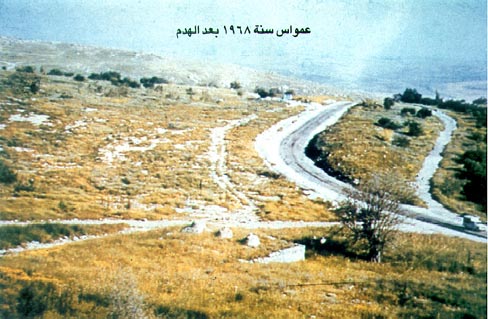
|
Refugees' migration route: Like their predecessors, the refugees from Lydda and Ramle in 1948, the villagers fled towards the Ramallah area. Many slept in Ramallah's bus station for at least a week, until they were invited in by some of their relatives in the area. Some made it on foot across the bombed Allenby bridge on the Jordan river to Amman, Jordan.
Ethnically cleansing by Israeli army: The village was completely ethnically cleansed. Some village inhabitants were ethnically cleansed twice: both in 1948 and in 1967. Terminating refugee camps: Many villagers fled to Ramallah and al-Bira to join relatives, and a few made it on foot across the borders to Amman, Jordan. Israeli settlements on town lands: Canada Park. (Based on http://www.palestineremembered.com/al-Ramla/Imwas/index.html)
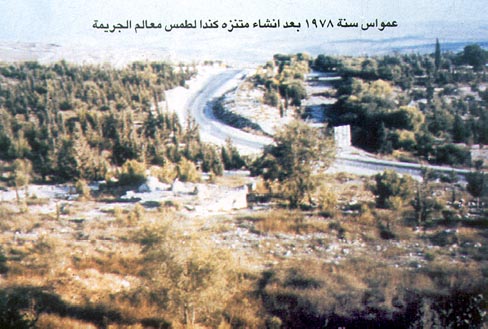
|
Eyewitness Report by the Author
Towards my departure to North America for my lecture tour on the subject of "Apartheid Israel and the Jewish National Fund: The Story of 'Imwas, Yalu, Beit Nuba and Canada Park" I undertook to do my fieldwork in the locality. I visited Canada Park on 2 September 2004, prior to my departure for my lecture tour, assisted by Adnan Abu Ghosh, a refugee of 'Imwas, and the on 9 October 2004, on my own. The signpost referred to by Trish Wood in her splendid 1991 documentary, "Park With No Peace: Canada Park" directing visitors to Canada Park one kilometer away is no longer there. According to workers on the Park, it has been removed some years back. An equally offensive signpost, however, is now posted at the approaches to Canada Park, directing the traffic to the wholly illegal settlement of Mevo Horon, built inside the post-1967 occupied territories on the lands of the destroyed Palestinian Arab village of Beit Nuba, and the new City of Modi'in, built in part inside the pre- 1967 armistice lines (the "Green Line" drawn in the 1949 armistice agreements signed between the State of Israel and its neighbouring Arab states signifying the cessation of the 1948-49 war hostilities) and in part inside the post-1967 occupied territories:
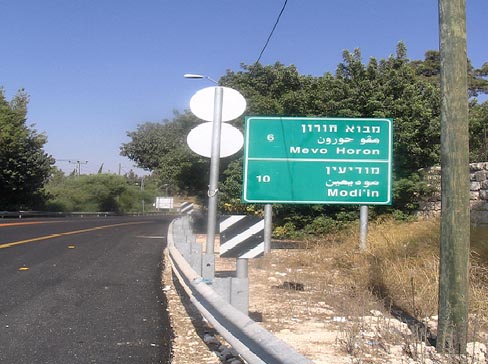
|
Similarly, at least some of the prominent JNF wooden signposts reported in Trish Wood's documentary above, designating the location as "Canada Park" have been replaced or modified to read "Ayalon Park",
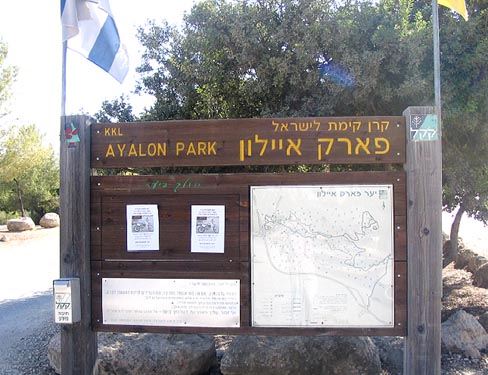
|
yet, when occasion requires, a multi-purpose nylon fiber banner is brought out:
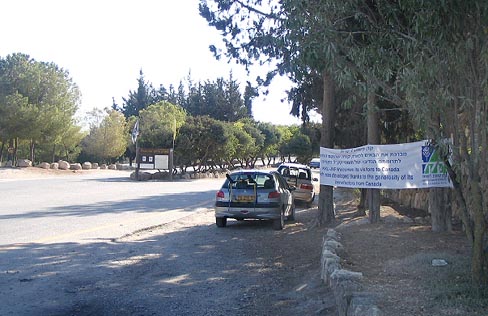
|
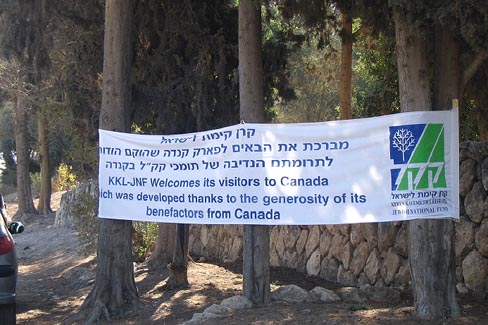
|
And the banner reads:
"KKL-JNF Welcomes its visitors to Canada Park which was developed thanks to the generosity of its benefactors from Canada"
A few hundred meters behind this JNF banner lies the desecrated cemetery of 'Imwas:
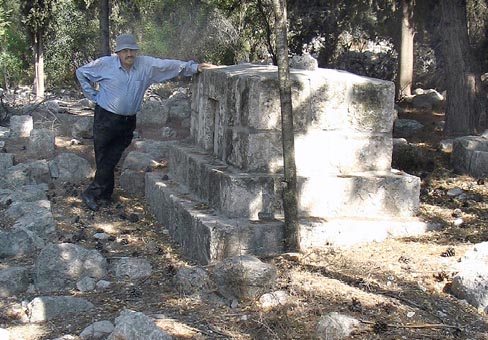
|
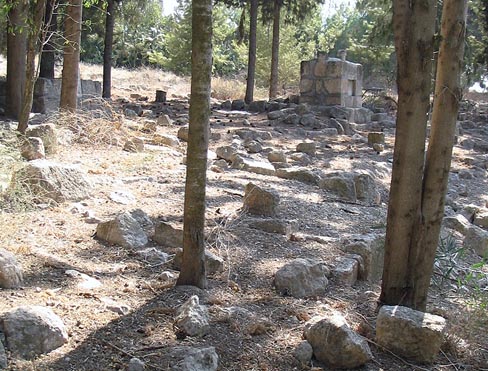
|
At the center of Canada Park, now renamed "Canada- Ayalon Park", the decorative commemoration walls acknowledging the names of the numerous Canadian and possibly other benefactors thanks to whose the generosity Canada Park was developed, with the most prominent plaque dedicated to Bernard M Bloomfield. The marble plaque reads:
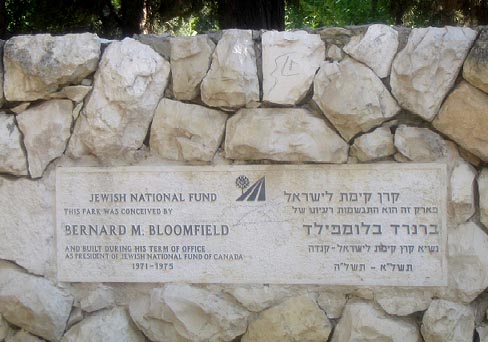
|
Jewish national Fund
This park was conceived by Bernard M Bloomfield and Built during his term of office as President of the Jewish national fund of Canada 1971-1975" Among the hundreds, if not thousands of Canadian benefactors, the names of the Prime Minister of Canada, the Honorable Paul martin, P.C. LL.D, Q.C. of Windsor Ontario is listed as well as the name of the Honorable William G Davis, Q.C., Premier of Ontario. The question of why should any citizen of Canada, let alone the Prime Minister of Canada or the Premier of Ontario lend their name to an exercise in complicity in a war crime, probably a crime against humanity and compromise the name of their country in a project developed in post-1967 Israeli occupies territories in blatant violation of international law and Canadian public policy still remains to be answered. One possible answer was that they gave contributions to Canada Park and allowed their names to be used in this manner because they were either misled or not fully informed by the JNF, in other words, because they were victims of a fraudulent misrepresentation.
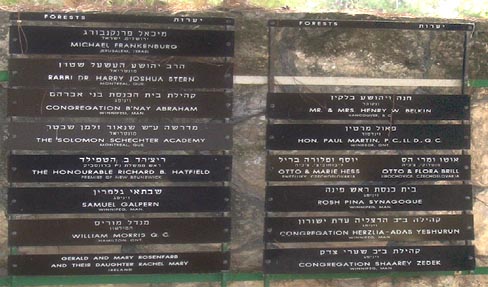
|
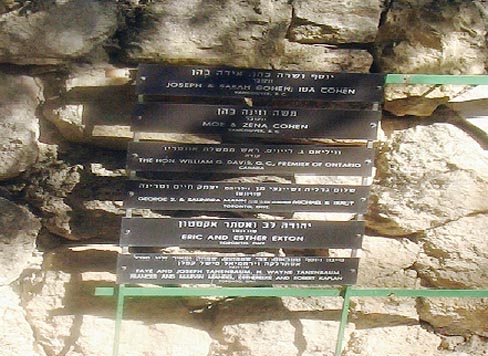
|
What Is the Jewish National Fund?
On 16 July 2004 the JNF Director of Communications in New York, NY, Sarina Roffe, posted a Press Release on the world wide web entitled "JNF Approved as United Nations Non Governmental Organization" reporting that the Jewish National Fund, "a 103-year-old international environmental organization with more than 50 offices around the globe, was approved this week by the United Nations Department of Public Information as an NGO, or Non-Governmental Organization."Quoting Yehiel Leket, World Chairman of KKL-JNF in Jerusalem, the Press Release further claimed that "Achieving UN status means that Jewish National Fund has more universal recognition and prestige in the international arena," and that the acceptance of the JNF by other countries into the United Nations legitimizes JNF "award-winning efforts in water, environment and sustainable development."
Joseph Hess, Vice President of Government Affairs for Jewish National Fund of America, is quite correct when he observes that "the NGO registration gives JNF an entree into the United Nations and an equal voice among internationally recognized environmental organizations on issues such as sustainable development, forestry, land management and water scarcity." Presumably when applying for recognition as an NGO with the UN Department of Information the JNF projected itself as a "non-profit organization founded in 1901 to serve as caretaker of the land of Israel, on behalf of its owners�Jewish people everywhere. During the first half of the 20th century, JNF set out to achieve its goal by purchasing the land that would become the State of Israel. Following the successful establishment of the state in 1948, the organization has evolved to meet Israel's most pressing needs, including the current security crisis, ongoing water shortage and other environmental challenges. Over the past century, the organization has planted over 240 million trees, built over 150 reservoirs and dams, developed over 250,000 acres of land, created more than 450 parks and educated students around the world about Israel and the environment." I doubt that the application papers presented to the UN included information such as the information documented above with reference to Canada Park. It is further in order to point out that he projection of the JNF as a non-profit organization amounts to a misrepresentation and the accreditation of the JNF as a Non-Governmental Organization by the UN suggests a major failure of the UN research departments.
The JNF is anything but an NGO. Though initially registered in 1907 in the UK under English law as a company limited by guarantee, under the style eventually fixed at "Keren Kayemeth Leisrael Limited." Following the establishment of the State of Israel in 1948, the Parliament of the newly established State of Israel, the Knesset, enacted the Keren Kayemeth Leisrael Law of 1953, subsequent to which, the JNF was registered as The Jewish National Fund (Keren Kayemeth Leisrael) in 1954 (omitting the word "Limited").
Under the said Law, Keren Kayemeth Leisrael Limited (the company registered in the UK) transferred to Keren Kayemeth Leisrael (the company established in Israel) all its assets situated in the area of Jurisdiction of the Israeli Government.
In 1961 the JNF and the Government of the State of Israel agreed a Covenant entitled "Covenant Between the State of Israel and the Keren Kayemeth Leisrael." The Covenant was signed in November 1961 with the sanction of the World Zionist organization (WZO). With the signing of the said Covenant any claim of the JNF to a non-governmental status is laughable, since under the terms of the said Covenant the JNF and the Government of the State of Israel are partners on an almost equal footing in the administration of 93 per cent of the territory under the sovereignty of the State of Israel in its pre-1967 borders (inside the so-called "Green Line"). As to JNF activities in the post-1967 occupied territories - the story of the destroyed Palestinian Arab villages of 'Imwas, Yalu and Beit Nuba and Canada Park is indicative, not only of much of JNF activities beyond the "Green Line", but also of JNF activities inside the "Green Line."
Appendix A below gives the full text of the said Covenant
In the language of the said Covenant the parties to this Covenant have therefore Agreed, inter alia, as follows:(Based on http://www.thelikud.org/Archives/Structure%20of%20the%20World%20Zionist%20 Organization.htm)
The Government shall establish a Board, under the chairmanship of the Minister, which shall lay down the land policy, approve the budget proposal of the Administration and supervise the activities of the Administration and the manner in which this Covenant is carried into effect. The number of the members of the Board shall be thirteen; half of them, less one, shall be appointed upon the proposal of Keren Kayemeth Leisrael. The members of the Board may be replaced in the same way as they were appointed. Notice of the appointment of the Board and of the names of its members, as appointed from time to time, shall be published in Reshumot [Official Gazette].
The reclamation and afforestation of Israel lands shall be concentrated in the hands of Keren Kayemeth Leisrael, which shall establish a "Land Development Administration" (hereinafter referred to as "the Development Administration") for that purpose. Keren Kayemeth Leisrael shall, after consultation with the Minister, appoint a Director to head the Development Administration, who shall be subordinate to Keren Kayemeth Leisrael.
The Development Administration shall draw up once a year (and for the first time at the expiration of three months from the day of the coming into force of the Law) a scheme for the development and afforestation of Israel lands, and shall submit that scheme to the Government and to Keren Kayemeth Leisrael. The scheme shall be drawn up in complete coordination with the Minister of Agriculture.
It is in terms of this partnership, inter alia, that the JNF has been engaged in the development of Canada Park. Hardly an NGO, clearly not charitable and definitely not deserving of a tax exempt status. As consequence of the (at this stage regrettably successful) misrepresentation of the JNF before the UN Department of Public Information as a nongovernmental organization committed to "water, environment and sustainable development" the JNF can now sponsor and present workshops at U.N. Conferences around the world, as well as apply to serve on environmental committees and the JNF in all countries in which JNF is active, including, of course, Canada, will now have access to the United Nations. There is little doubt in the mind of this writer that when a fuller presentation of the JNF is brought before the UN Department of Public Information, or, if necessary, the decision of the UN Department of Public Recognition is challenged through an appropriate appeals procedure inside the UN the UN recognition of the JNF as a bona fide NGO will be nullified.
The Case for the Nullification of th Charitable Status of the Jewish National Fund of Canada and its Tax Exempt Status.
Given the above, it is evident that the JNF is not an NGO.
Given the above, it is obvious that the JNF does not deserve to be classified as a charitable association, and ought not be granted tax exemption in Canada, or for that matter elsewhere.
How come, then, that what is so plainly the case, has been obfuscated in the public view?
A part explanation of the discrepancy has to do with the specific structures of Israeli apartheid: both in its similarities as well as its divergencies from South African apartheid.
With the establishment of the State of Israel in May 1948, the legal status of the landholdings, properties and operations of inter alia the World Zionist Organization (WZO), the Jewish Agency for the Land of Israel (JA) and the Jewish National Fund (JNF) inside the State of Israel had to be regularized. Following the establishment of the state, a fundamental legal and political circle had to be squared. On the one hand, the new state was politically and legally committed to the values of the Universal Declaration of Human Rights, the Charter of the United Nations Organization, and the standards of international law, which, since the Second World War inform most, if not all, liberal western democracies and enlightened world public opinion. On the other hand, the driving force underpinning the efforts of political Zionism since its establishment at the First Zionist Congress was not liberal democratic, but ethnocratic, namely, the attempt to establish in Palestine a state that would be as "Jewish" as England was "English", namely, establish and consolidate in the country of Palestine a sovereign state, a Jewish state, that attempts to guarantee in law and in practice a demographic majority of the Jewish tribes in the territories under its control - an apartheid state.
Clearly, the political Zionist efforts to create in all or in a part of the country of Palestine a Jewish majority ex nihilo, could not but further entail the dispossession and expulsion of the majority of the native indigenous population from the territories of the projected Jewish state, and the legislation of the remnants of the non-Jewish, largely Palestinian Arab, population remaining under Israeli rule into the status of second and third-class citizens.
Racism is not apartheid and apartheid is not racism. Apartheid is a political system where racism is regulated in law through Acts of Parliament. Racism is regrettably prevalent in all states, including liberal democratic states such as the current western liberal democracies. But in liberal democratic states, those victimized by racism have constitutional recourse to seek the protection of the law under a democratic Constitution, namely a Constitution that embodies the values of the Universal Declaration of Human Rights. In apartheid state, on the other hand the state enforces racism through the legal system, obligating the citizenry through Acts of Parliament to conform to racist behaviour and criminalizes expressions of humanitarian concern. But it was equally clear to the political Zionist leadership that successfully steered the establishment of the Jewish state from its modest beginning in the first Zionist Congress in 1897 through to its admission as a member state in the UN fifty years later in 1949, that for a state constituted by a UN General Assembly resolution (Resolution 181(II) and admitted to the UN on the basis of its declaration that the State of Israel "unreservedly accepts the obligations of the United Nations charter and undertakes to honour them from the day when it becomes a member of the United Nations" (Mussa Mazzawi, 1997:129). it was imperative to be able to project the Jewish state as "the only democracy in the Middle East". Israel's admission to the UN, let alone its continued membership in the UN depended on it.
The world community, having defeated the Nazi Third Reich, emerged, scarred and smoldering, from the devastation and the horrific slaughter of the Second World War with the Universal Declaration of Human Rights, adopted by the UN General Assembly on 10 December 1948 (five month prior to the admission of Israel as a member state of the UN on 11 May 1949) declaring that
Whereas recognition of the inherent dignity and of the equal and inalienable rights of all members of the human family is the foundation of freedom, justice and peace in the world,
Whereas disregard and contempt for human rights have resulted in barbarous acts which have outraged the conscience of mankind, and the advent of a world in which human beings shall enjoy freedom of speech and belief and freedom from fear and want has been proclaimed as the highest aspiration of the common people,
Whereas it is essential, if man is not to be compelled to have recourse, as a last resort, to rebellion against tyranny and oppression, that human rights should be protected by the rule of law, The Nazi occupation of Europe and the Holocaust notwithstanding, the State of Israel would not have been able to project itself in the West as successfully as it has done since its establishment in 1948 as the "only democracy in the Middle East" without elaborately veiling its apartheid legislation.
In all that pertains to the core of the Israeli-Palestinian conflict, Israeli apartheid (enforcing segregation and discrimination in law between "Jews" and "non-Jews") is closely akin to South African apartheid (enforcing segregation and discrimination in law between "Whites" and "non-Whites"). At the height of South African apartheid 87 per cent of the land was reserved in law for the settlement, cultivation and development of "Whites" only, whereas in Israel to date 93 per cent of the land (the so-called "Israel lands" administered by the Israel Lands Administration) is reserved in law for the settlement, cultivation and development for "Jews" only.
It is in order to point out in this connection that no person, Jew, Arab or whatever, may purchase land, in the sense of freehold purchase, in 93 per cent of the territory of the State of Israel, namely, the lands administered by the Israel lands Administration (ILA). Other than in the remaining seven or so per cent of privately owned land, land in the State of Israel is available only on a leasehold basis, the leaseholds being issued by the ILA. However, only persons recognized in law as "Jews" can expect to obtain long term inheritable (49 years or multiples of 49 years) leasehold. Persons classified in law as "non-Jews", first and foremost Arabs, are denied such leasehold, except inside the areas of municipal jurisdiction of Arab municipalities, that is, except inside two and a half percent of the total area of municipal jurisdiction of the State of Israel, the ruling of the Israeli High Court, sitting as the Supreme Court of Justice on the case of the Qaadan family versus the cooperative community settlement of Qatzir in 2000, notwithstanding).
But unlike the apartheid legislator in South Africa, the Israeli legislator, the Knesset, refrained from legislating "petty apartheid". Any visitor to the Republic of South Africa in the decades of apartheid would have apartheid hit him or her straight in the face upon disembarkation from the ship or the aircraft: passport control queues for "Whites" versus passport control queues for "non-Whites"; toilettes for "Whites" versus toilettes for "non-Whites"; transport for "Whites" versus transport for 'non- Whites"; benches for "Whites" versus benches for "non-Whites"; parks for "Whites" versus parks for "non-Whites" etc.
Apartheid would not hit the visitor to Israel in the same way. The Israeli legislator refrained from legislating "petty apartheid" in Israel. There are no passport control queues for "Jews" versus passport control queues for "non-Jews"; toilettes for "Jews" versus toilettes for "non-Jews"; transport for "Jews" versus transport for 'non-Jews"; benches for "Jews" versus benches for "non-Jews"; parks for "Jews" versus parks for "non-Jews" etc. Jewish national Parks, for instance are not segregated. Visitors to JNF parks and recreational facilities on weekends or public holidays would witness hosts of Arab families happily barbequing next to mass of Jewish families, with their children joyously playing in the playground.
It is the absence of "petty apartheid" in Israel that contributes to the veiling of Israeli "core apartheid" - and it is in the weaving of this veil that the JNF plays a critical role.
JNF forests, parks and recreational facilities are not segregated - but, like Canada Park, they are mostly developed over ruins of Palestinian Arab villages, some 400 in all, destroyed by the Israeli army mostly, but not exclusively, in the course of and in the wake of the 1948-49 war. 'Imwas Yalu and beit Nuba were ethnically cleansed and razed to the ground by the Israeli army in the course of and in the wake of the 1967 war - a war crime, if not a crime against humanity under international law. Does the fact that there is no "petty apartheid" in JNF parks exonerate the JNF from complicity in war crimes and crimes against humanity? Does the fact that Arab families are able to entertain barbeques alongside Jewish families in JNF recreational facilities represent a relevant counterweight to the nullification of the property rights of the Palestinian Arab refugees ethnically cleansed from the localities where the JNF forests are planted and its recreational facilities developed and the nullification of their right to return? Should the planting of forests and the development of recreational parks over the ruins of destroyed Palestinian Arab villages anywhere in Palestine, and specifically inside the post-1967 Israeli occupied territories be classified as a charitable activity or complicity in war crimes? And if such activities are classified as complicity in war crimes, as, in the view of this writer they should, ought not the Canadian authorities nullify the charitable registration and the tax exempt status of the JNF of Canada without delay?
By classifying the JNF of Canada as a charity and authorizing a tax exempt status for donations to the JNF of Canada the State of Canada and the entire people of Canada are implicated in complicity in a war crime, since the tax exempt status of the JNF of Canada allows donors to the JNF present the JNF receipts representing their donations before their tax officers and get corresponding tax deductions. These tax deductions are drawn out of the commonweal, namely out of the pocket of each tax paying person in Canada.
The least that every tax paying person in Canada ought to do in the face of such odious complicity in war crimes is mobilize as vigorously as they are able to, raise their banners as high as they can, and shout at the top of their voices: NOT IN MY NAME!
And the least the Canada Customs and Revenue Agency can do is demand from the JNF official answers to the following questions:
- Is the dispossession of the indigenous people of 'Imwas, Yalu and Beit Nuba; the razing down of their homes; the planting of forests on the ruins of their homes and on their lands; and the appropriation of their properties to build recreational facilities regulated through Acts of Knesset;
- Is the JNF an official partner and beneficiary to the Government of Israel in the application of such instruments of Israeli legislation as the Absentees Property Law of 1950;
- Is the JNF still committed to purchase, take on lease or in exchange, or otherwise acquire any lands, forests, rights of possession and other rights, easements and other immovable property (including 1948 Palestine refugees property) for the purpose of settling Jews AND ONLY JEWS on these lands;
- Is Canada Park (also known as Ayalon Park) planted in full or in part over the ruins of and/or on the lands of any and/or all of the destroyed Palestinian Arab villages of 'Imwas, Yalu and Beit Nuba occupied by the Israeli army in the 1967 war?
Uri Davis (Dr)
P O Box 99
Sakhnin 20173
Israel
E-mail: uridavis@actcom.co.il
Cellular: 00 972 54 452 3838
Fax: 00 972 4 674 7028 & 04 625 7306
Tel: 00 972 4 674 7016
Bibliography
Uri Davis, Apartheid Israel: Possibilities for the Struggle Within, Zed Books, London 2003.Uri Davis, associate author, and Walter Lehn, author, The Jewish National Fund, Kegan Paul International, London 1988
Sami Hadawi, Palestinian Rights and Losses in 1948: A Comprehensive Study, Saqi Books, London, 1988.
'Imwas Charitable Association, Diary 2000. Ramallah.
Amos Kenan, Israel: A Wasted Victory, Amikam Publishers, Tel Aviv, 1970, pp 18- 21
Walid Khalidi All That remains: The Palestinian Villages Occupied and Depopulated by Israel in 1948, Institute for Palestine Studies, Washington DC, 1992
Walter Lehn, "West Bank Sojourn", Journal of Palestine Studies, Vol IX, No 4, Issue 36, Summer 1980, pp 3-16.
Walid Khalidi All That remains: The Palestinian Villages Occupied and Depopulated by Israel in 1948, Institute for Palestine Studies, Washington DC, 1992.
Yeshaayahu Leibowitz, Judaism, Human Values and the Jewish State (Edited by Eliezer Goldman), Harvard University Press, Cambridge, MASS, 1992.
- - - - -, On Just About Everything: Talks With Michael Shashar, Keter Publishing House, Jerusalem, 1987
Musa Mazzawi, Palestine and the Law: Guidelines for the Resolution of the Arab- Israel Conflict, Ithaca Press, Reading, 1997.
Akiva Orr, Israel: Politics, Myths and Identity Crises, Pluto Press, London, 1994.
Edward Said and Christopher Hitchens, Blaming the Victim, Verso, London, 1988.
Israel Shahak, The Zionist Plans for the Middle East, Association of Arab American University Graduates (AAUG), Belmont MASS, 1982.
Trish Wood, "Park With No Peace: Canada Park", Canada Broadcasting Corporation (CBC), 5th Estate, 22 October 1991.
Ismail Zayid, "Canada Park: Canadian Complicity in a War Crime", Outlook, September/October Issue, 2001
Appendix A
COVENANT BETWEEN THE STATE OF ISRAEL AND THE KEREN KAYEMETH LeISRAEL*Signed on 28th November, 1961
THIS IS THE COVENANT MADE THIS DAY IN JERUSALEM BETWEEN THE STATE OF ISRAEL, REPRESENTED FOR THIS PURPOSE BY THE MINISTER OF FINANCE, AND KEREN KAYEMETH LEISRAEL - WITH THE SANCTION OF THE WORLD ZIONIST ORGANIZATION - REPRESENTED FOR THIS PURPOSE BY THE CHAIRMAN OF THE BOARD OF DIRECTORS OF KEREN KAYEMETH LEISRAEL.
A. Since its inception more than half a century ago, Keren Kayemeth Leisrael has been engaged in acquiring land in Palestine and transferring it to the ownership of the people, reclaiming and afforesting land, leasing out land for settlement and housing, and administering its lands. The fundamental principle of Keren Kayemeth Leisrael is that its lands shall not be sold, but shall remain the property of the people and shall be given on lease only.
B. After the establishment of the State, the volume of the acquisition of land by Keren Kayemeth Leisrael from non-Jewish owners has decreased, while the extent of the redemption of land from desolation has steadily increased. The State had become the owner of most of the land in Israel, and the Government administers and develops these domains.
C. The Government of Israel and Keren Kayemeth LeIsrael have resolved to end the duplication resulting from the administration of their lands by different agencies, to concentrate the administration, conservation and care of these lands in the hands of the State, and to strengthen the hands of Keren Kayemeth Leisrael in fulfilling its mission of redeeming land from desolation.
The parties to this Covenant have therefore agreed as follows:
1. Upon the coming into force of the Basic Law: Israel Lands (hereinafter referred to as "the Law"), the administration of the lands which are State land or land of the Development Authority or land of Keren Kayemeth Leisrael, whether acquired in the past or to be acquired in the future, shall be concentrated in the hands of the State.IN WITNESS WHEREOF THERE HAVE HEREUNTO SET THEIR SIGNATURES, on behalf of the State of Israel, the Minister of Finance, Mr. Levi Eshkol, and on behalf of Keren Kayemeth Leisrael, the Chairman of the Board of Directors thereof, Mr. Jacob Tsur, in Jerusalem, this 20th day of Kislev, 5722 (28th November, 1961).
2. The Government shall establish an "Israel Lands Administration" (hereinafter referred to as "the Administration") and shall, after consultation with Keren Kayemeth Leisrael, appoint a Director to head the Administration. The Director shall be subordinate to the Minister charged by the Government with the implementation of this Covenant (hereinafter referred to as "the Minister"). 3. Notwithstanding the provision of clause 1, there shall be no change in the ownership of the lands as registered in the Land Registry, save to the extent that the parties to this Covenant agree, in respect of particular lands, to register them in the name of the State or in the name of Keren Kayemeth Leisrael, either by way of exchange or in any other manner.
4. Israel lands shall be administered in accordance with the law, that is to say, on the principle that land is not sold, but only given on lease, and in accordance with the land policy laid down by the Board established under clause 9. The Board shall lay down a land policy with a view to increasing the absorptive capacity of the land and preventing the concentration of lands in the hands of individuals. The lands of Keren Kayemeth Leisrael shall, moreover, be administered subject to the Memorandum and Articles of Association of Keren Kayemeth Leisrael.
5. Where the Administration, in respect of a particular transaction, deems it necessary to deviate, in one or the other detail, from the principles of the land policy referred to in clause 4, such transaction shall only be made with the approval of the Board established under clause 9 and, where land registered in the name of Keren Kayemeth is concerned, with the consent of Keren Kayemeth Leisrael or, where other Israel land is concerned, with the consent of the Minister.
6. Any transaction in respect of Israel land shall be entered into by the Administration on behalf of and as the agent of the registered owner of such land, and any proceeds of Israel land shall be the property of the registered owner; and the State accepts, in consideration of this Covenant, to bear the expenses of the Administration.
7. The Administration shall deliver to the registered owners of Israel land, once every three months (and for the first time at the expiration of six months from the day of the coming into force of the Law), a report of the income and expenditure of the administration of their land. The expenditure shall include a fixed amount determined by the Administration, either as a certain percentage of the income or as a quota on a certain unit of measurement of the land. Upon the delivery of such a report, any balance appearing therein to the credit of Keren Kayemeth Leisrael shall be regarded as a debt due to it and payable by the State, and any balance appearing therein to the debit of Keren Kayemeth Leisrael shall be regarded as a debt due from it and payable to the State.
8. The Administration shall deliver to the Government and to Keren Kayemeth Leisrael, once a year, a report of all its activities.
9. The Government shall establish a Board, under the chairmanship of the Minister, which shall lay down the land policy, approve the budget proposal of the Administration and supervise the activities of the Administration and the manner in which this Covenant is carried into effect. The number of the members of the Board shall be thirteen; half of them, less one, shall be appointed upon the proposal of Keren Kayemeth Leisrael. The members of the Board may be replaced in the same way as they were appointed. Notice of the appointment of the Board and of the names of its members, as appointed from time to time, shall be published in Reshumot.
10. The reclamation and afforestation of Israel lands shall be concentrated in the hands of Keren Kayemeth Leisrael, which shall establish a "Land Development Administration" (hereinafter referred to as "the Development Administration") for that purpose. Keren Kayemeth Leisrael shall, after consultation with the Minister, appoint a Director to head the Development Administration, who shall be subordinate to Keren Kayemeth Leisrael.
11. The Development Administration shall draw up once a year (and for the first time at the expiration of three months from the day of the coming into force of the Law) a scheme for the development and afforestation of Israel lands, and shall submit that scheme to the Government and to Keren Kayemeth Leisrael. The scheme shall be drawn up in complete coordination with the Minister of Agriculture.
12. The Afforestation Section of the Ministry of Agriculture shall henceforth engage in afforestation research only. However, the Minister of Agriculture shall continue to be charged with the implementation of the Forestry Ordinance, 1926, through the Development Administration.
13. The Develpment Administration shall engage in operations of reclamation, development and afforestation of Israel lands as the agent of the registered owners; and Keren Kayemeth accepts in consideration of this Covenant, to bear the administrative expenses of the Development Administration.
14. The expenditure involved in operations of reclamation, development and afforestation of Israel lands shall fall on the registered owners of the land on which the operation is carried out; and the Develpment Administration shall deliver once every six months (and for the first time at the expiration of nine months from the day of the coming into force of the Law) a report to the registered owners of expenditure as aforesaid incurred in respect of their lands. Upon the delivery of a report as aforesaid, any balance appearing therein to the debit of the State or the Development Authority shall be regarded as a debt due from them and payable to Keren Kayemeth Leisrael. Where the Government requests the Development Administration to carry out operations of reclamation, development or afforestation of land registered in the name of Keren Kayemeth Leisrael, and Keren Kayemeth Leisrael notifies the Government, in writing, before carrying out the operation, that it is unable to carry it out at its expense, the State shall bear the expenditure involved in the operation, and the amount thereof shall be paid to Keren Kayemeth either by a grant, loan or exchange of property or in any other manner, as may be agreed upon between the Government and Keren Kayemeth Leisrael.
15. The Board for Land Reclamation and Development attached to Keren Kayemeth Leisrael shall lay down the development policy in accordance with the agricultural development scheme of the Minister of Agriculture, shall approve the budget proposal of the development Administration, and shall supervise the activities of the Development Administration and the manner in which it carries this Covenant into effect. The number of the members of the Board shall be thirteen; half of them, less one, shall be appointed by the Government. The members of the Board may be replaced in the same way as they were appointed. The Board shall be headed by the Chairman of the Board of Directors of Keren Kayemeth Leisrael or a person appointed in that behalf by Keren Kayemeth Leisrael.
16. Keren Kayemeth Leisrael shall continue to operate, as an independent agency of the World Zionist Organization, among the Jewish public in Israel and the Diaspora, raising funds for the redemption of land from desolation and conducting informational and Zionist-Israel educational activities; and the Government shall extend assistance to Keren Kayemeth Leisrael in informational and propaganda activities in Israel and abroad.
17. This Covenant shall come into force on the day of the coming into force of the Law and shall remain in force for five years. Unless one of the parties to this Covenant, at least six months before the expiration of the five years, announces its intention not to renew it, its validity shall be automatically extended for another five years; and so on indefinitely from five-year-period to five-yearperiod.
18. If the Law is repealed or amended, Keren Kayemeth Leisrael may withdraw from this Covenant by giving notice of withdrawal, in writing, to the Government; however, Keren Kayemeth Leisrael may not withdraw from this Covenant if the Government notified it in advance, in writing, of the proposed amendment or repeal, and Keren Kayemeth Leisrael did not express opposition.
19. If this Covenant becomes void, whether by virtue of clause 17 or by virtue of clause 18, the position which existed immediately before the coming into force of the Law shall be restored; the Government undertakes to propose the necessary legislation to the Knesset.
20. If one of the parties to this Covenant considers that a change should be made therein, it shall give written notice to the other party, which shall reply to the proposal, favourably or unfavourably, within six months from the day on which notice is given. If the reply is favourable, the Covenant shall be deemed amended, in accordance with the proposal received from the day on which the reply is given.
21. From the day of the signing of this Covenant, the parties thereto shall do everything necessary and expedient for the implementation thereof and shall be bound by it in all respects.
LEVI ESHKOL
Minister of Finance
JACOB TSUR
Chairman of the Board of Directors
of Keren Kayemeth Leisrael
* The text of this translation is not binding, the only authentic text being the Hebrew original.
About the Author
Dr Uri Davis was born in Jerusalem in 1943. He has been at the forefront of the defence of human rights, notably Palestinian rights, since 1965 and has pioneered critical research on Zionism and Israel since the mid-1970. He has published extensively in these fields, including Israel: An Apartheid State (Zed Books, London 1987 & 1990; abridged edition, MRN, Laudium, 2001); Citizenship and the State: Comparative Study of Citizenship Legislation in Israel, Jordan, Palestine, Syria and Lebanon (Ithaca Press, Reading, 1997); Citizenship and the State in the Middle East: Approaches and Applications (co-ed) (Syracuse University Press, 2000) and most recently Apartheid Israel: Possibilities for the Struggle Within, Zed Books, London, 2003..Dr Davis is an Observer-Member of the Palestine National Council (PNC); member of the Middle East Regional Committee of the international journal Citizenship Studies; Honorary Research Fellow at the Institute for Middle Eastern & Islamic Studies (IMEIS), University of Durham and Honorary Research Fellow at the Institute of Arab & Islamic Studies (IAIS), University of Exeter; Chairperson of AL-BEIT: Association for the Defence of Human Rights in Israel and MAIAP: Movement Against Israeli Apartheid in Palestine; founding member and Senior Director for Legal and Political Affairs, Mosaic Communities: Multinational Housing Cooperative in Israel.